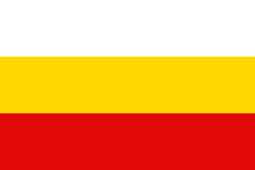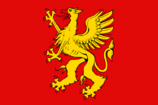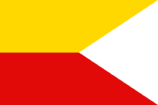Flag of Elstock: Difference between revisions
| Line 32: | Line 32: | ||
The flag was first officially adopted by joint [[Tyrnica|Tyrnican]]-[[Pelemia|Pelemian]] authorities in 1919 alongside a {{wp|Swallowtail (flag)|swallowtail}} of gold and red as the city's {{wp|civil ensign|Civil}} and {{wp|state ensign}}, as designated by an amendment to the 1915 ''Symbols of the Territory of Elstock Act''. In preparation for independence in 1999, a secondary state flag consisting of a red field charged with a gold griffin was made official through the constitution, which maintained the triband as the official flag of the city-state. | The flag was first officially adopted by joint [[Tyrnica|Tyrnican]]-[[Pelemia|Pelemian]] authorities in 1919 alongside a {{wp|Swallowtail (flag)|swallowtail}} of gold and red as the city's {{wp|civil ensign|Civil}} and {{wp|state ensign}}, as designated by an amendment to the 1915 ''Symbols of the Territory of Elstock Act''. In preparation for independence in 1999, a secondary state flag consisting of a red field charged with a gold griffin was made official through the constitution, which maintained the triband as the official flag of the city-state. | ||
==History== | ==History== | ||
The colours of the flag of Elstock originate from the city's coat of arms, which depict a gold griffin on a red field. The colours of gold (oftentimes also just referred to as yellow) and red later appeared on a bisected {{wp|Swallowtail (flag)|swallowtail}} in the 13th century, meant to mark ships under the employ of Elstocker merchants. This flag, alongside the city's {{wp|banner of arms}}, would become a symbol for the city throughout the early modern period, surviving the collapse of the [[ | The colours of the flag of Elstock originate from the city's coat of arms, which depict a gold griffin on a red field. The colours of gold (oftentimes also just referred to as yellow) and red later appeared on a bisected {{wp|Swallowtail (flag)|swallowtail}} in the 13th century, meant to mark ships under the employ of Elstocker merchants. This flag, alongside the city's {{wp|banner of arms}}, would become a symbol for the city throughout the early modern period, surviving the collapse of the [[Elstock#Decline and the early modern period|Elsian March]] and Pelemian control of Elstock. | ||
The first attested appearance of the modern triband was in 1867 during a rally protesting language restrictions in the town of Bãdzyń (now Bendzin, Pelemia). Popular folklore attributes the addition of a white stripe to the gold and red as a symbol of peace and aspiration for autonomy, and the flag quickly became popular within Elsian nationalist circles, who adopted the symbols of Elstock to represent the Elsian community at large. | The first attested appearance of the modern triband was in 1867 during a rally protesting language restrictions in the town of Bãdzyń (now Bendzin, Pelemia). Popular folklore attributes the addition of a white stripe to the gold and red as a symbol of peace and aspiration for autonomy, and the flag quickly became popular within Elsian nationalist circles, who adopted the symbols of Elstock to represent the Elsian community at large. | ||
Revision as of 18:41, 28 April 2022
 | |
| Use | Civil and state flag |
|---|---|
| Proportion | 3:5 |
| Adopted | 10 August 1919 |
| Design | A horizontal triband of white, gold, and red |
 Variant flag of Elstock | |
| Use | State flag |
| Proportion | 3:5 |
| Adopted | 21 March 1999 |
| Design | A red field charged with a gold griffin rampant |
 Variant flag of Elstock | |
| Use | Civil and state ensign |
| Proportion | 3:5 |
| Adopted | 10 August 1919 |
| Design | A horizontal bicolour of gold and red |
The flag of Elstock (Elsian: fana Elstóku; Tyrnican: Flagge Elstocks), also referred to as the White-Gold-Red (Elsian: Biôłi-Złoto-Czerwòny; Tyrnican: Weiß-Gold-Rot), is the civil and state flag of the Free City of Elstock, consisting of a horizontal triband made up of three equal bands of white, gold, and red. The flag is deliberately identical to the flag of the Elsian ethnic group, who form a majority of Elstock's population, as well as nearly identical to the flag of the Senian region of Cernia, differing in only hue and proportions.
The flag was first officially adopted by joint Tyrnican-Pelemian authorities in 1919 alongside a swallowtail of gold and red as the city's Civil and state ensign, as designated by an amendment to the 1915 Symbols of the Territory of Elstock Act. In preparation for independence in 1999, a secondary state flag consisting of a red field charged with a gold griffin was made official through the constitution, which maintained the triband as the official flag of the city-state.
History
The colours of the flag of Elstock originate from the city's coat of arms, which depict a gold griffin on a red field. The colours of gold (oftentimes also just referred to as yellow) and red later appeared on a bisected swallowtail in the 13th century, meant to mark ships under the employ of Elstocker merchants. This flag, alongside the city's banner of arms, would become a symbol for the city throughout the early modern period, surviving the collapse of the Elsian March and Pelemian control of Elstock.
The first attested appearance of the modern triband was in 1867 during a rally protesting language restrictions in the town of Bãdzyń (now Bendzin, Pelemia). Popular folklore attributes the addition of a white stripe to the gold and red as a symbol of peace and aspiration for autonomy, and the flag quickly became popular within Elsian nationalist circles, who adopted the symbols of Elstock to represent the Elsian community at large.
With the creation of Elstock as a condominium under joint rule by Tyrnica and Pelemia in 1914, attempts were made to create a flag for the territory that was deliberately separated from Elsian nationalism. The territory's first flag, adopted in 1915 and consisting of a green, white, and blue triband with the name of the city in Tyrnican, Elsian, and Dlin in the centre band, proved unpopular with both the public and authorities, and in 1916 the wording was removed and replaced by three gold stars. In 1919, after protests and riots continued against the flag, condominium authorities acquiesced and amended the Symbols of the Territory of Elstock Act to officially adopted the white-gold-red triband as the condominium's official flag. It has retained this position after independence in 2000.
Proportions and colours
The official proportions of the flag is 3:5, in accordance with the 1999 constitution. The flag's colours were also officially specified in 1999, and later amended in 2011 to address the use of the flag as an image on the Internet and social media.
| Colours | White | Gold | Red |
|---|---|---|---|
| Pantone | Pure white | Medium Yellow C | 2347 C |
| CMYK | 0-0-0-0 | 0-15-100-0 | 0-96-96-11 |
| RGB | 255-255-255 | 255-216-0 | 226-9-9 |
| Hexadecimal | #FFFFFF | #FFD800 | #E20909 |




